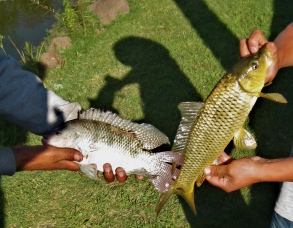
Aquaponics in Mexico
March 11, 2014
By David Scarratt
 La Senda Ecovilla
La Senda EcovillaA few kilometers from San Miguel de Allende, in the heart of the Mexican altiplano, lies La Senda Ecovilla, designed as a self-sufficient, sustainable community by Rick and Barbara Welland. It fronts onto the Rio Laja, below the Presa Allende dam, built over 50 years ago to control flooding, and provide water for irrigating farmland further south. At my most recent visit it was still a work in progress, but the basic elements are in place, and the ‘sustainability’ part is beginning to take shape.
The main building comprising six small self-contained apartments faces south to maximize solar gain, and overlooks a plastic-lined ‘production’ pond roughly 32 x 14m by about 60cm deep. This is home for a significant shoal of tilapia. On the roof are solar water heaters and electric panels. The site is not “off-grid,” but under Mexican law, electricity generated during daytime can be fed into the national grid and drawn off at night at no cost.
Below the production pond lies an oxbow, perhaps 200m long and 10-15m wide, and beyond that the river itself. Water level in the oxbow is maintained by infiltration through the bank and a sluiceway at the downstream end. The oxbow is full of fish. Tilapia (Oreochromis niloticus) were introduced to the Laja many years ago and breed naturally here. They are caught and transferred to the upper pond for breeding and grow-out.
Elsewhere the site has been planted with fruit trees and conventional vegetables, which are ‘drip’ irrigated with water from the oxbow pool pumped up to storage tanks (tinacos) located by the road.
But the heart of the enterprise is aquaponics. Water from the production pond is pumped to three of the tinacos, and flows by gravity through a cascade of troughs arranged on the natural slope of the land between the main building and the road, under a white plastic greenhouse.
Lettuce and tomatoes were growing in small pots suspended in the water. Other plants included peppers; eggplant; a delicious local spicy watercress; Stevia – a South American herb that is 30 times sweeter than sugar; and other plants such as Moringa, that, when taller, will provide shade. Moringa leaves have high concentrations of protein and are being incorporated into the fish feed as well as the domestic salad bar.
Rick aims toward low intensity production with all nutrients for the fish coming from the site. Full carrying capacity has yet to be determined.
La Huerta is at an altitude of 1800m so winter nights can be cool. May is the hottest month with daytime temperatures often exceeding 30°C, so fish grow well in the summer, and Rick anticipates production sufficient to nourish a weekly crop of 500 head of lettuce, or the equivalent in tomatoes or peppers.
Having gotten rid of carnivorous ‘lobina’ (largemouth bass Micropterus salmoides, another introduced species) from his production pond Rick finds the tilapia are breeding well. From the first 15 fish introduced the stock now numbers in the thousands, and some are being harvested. Growth is slow, and feed remains an issue. Last summer they experienced a huge population of grasshoppers, which tilapia love, and which helped to reduce costs, though it takes time to catch and prepare them.
Rick has also discovered that the aquaponics section needs some tweaking. Covering the trays with black plastic has reduced algal growth and the plants now have cleaner roots and are growing better. The gardens, drip-irrigated with pond water, are doing well. There are flourishing crops corn, beans and squash (the Mexican essentials) and lots of spinach, chard, lettuce, onions, etc. for sale in San Miguel’s organic stores. Overall self-sufficiency is still an issue, and solving that remains a priority, but La Senda is slowly becoming a productive integrated farm.
For more information visit: http://www.lasendaecovilla.org/
– David Scarratt





